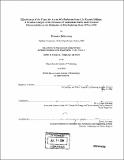Effectiveness of the Clean Air Act on SO₂ emissions from U.S. electric utilities : a detailed analysis of the influence of attainment status and unit-level characteristics on the reduction of SO₂ emissions from 1976 to 2002
Author(s)
Dubroeucq, Florence
DownloadFull printable version (4.904Mb)
Other Contributors
Massachusetts Institute of Technology. Technology and Policy Program.
Advisor
A. Denny Ellerman.
Terms of use
Metadata
Show full item recordAbstract
The continuing degradation of air quality in the U.S. during the 1950s and 1960s has led to increasing federal regulations to control air pollution. The Clean Air Act Amendments of 1970 and 1977 were major pieces of legislation to impose tight controls on air polluters. One of the major pollution issues targeted by the legislation was the excessive level of sulfur dioxide emissions from the U.S. fossil fuel electric utilities, which represent more than two third of the total U.S. SO₂ emissions. The emissions have been lowered down by about 40% between 1970 and 2002. But that does not indicate whether those reductions are the consequence of the regulations or the consequence of other factors. The purpose of this thesis is to address the question of whether the Clean Air Act SO₂ regulations had an effect on the SO₂ emissions reduction at fossil fuel electric utilities. The regulations consist of a maximum allowed level of SO₂ ambient concentration, which every state has to meet by regulating the pollution sources within the state. Concentrations levels are controlled on an hourly basis by a large network of monitoring stations. We start from the hypothesis that if the Clean Air Act has been the driver of the SO₂ emissions reduction at electric utilities, there should be a correspondence between the monitors' readings and the subsequent emissions reduction. In this research we confront two major database, (a) the yearly summary of the SO₂ readings at each monitor from 1970 to 2002 and (b) the heat input' and SO₂ emissions data from U.S. electric utilities at the unit (turbine) level from 1980 through 2002, as well as corresponding plant-level data from 1976. After a detailed presentation of both databases, the thesis then presents the results of an (cont.) econometric study of the correspondence between concentration readings and consecutive emissions reduction. We find a correspondence between monitors' readings and subsequent emissions reduction for the reduction which occurs from 1980 to 1985. We find no evidence of a regulatory impact of the readings in other time periods.
Description
Thesis (S.M.)--Massachusetts Institute of Technology, Engineering Systems Division, Technology and Policy Program, 2004. Includes bibliographical references (p. 53).
Date issued
2004Department
Massachusetts Institute of Technology. Engineering Systems Division; Technology and Policy ProgramPublisher
Massachusetts Institute of Technology
Keywords
Technology and Policy Program.